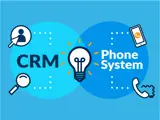Improving employee productivity and other reasons, you should integrate your telephony system and your CRM.
Integrating telephony into CRM
It has been over two years since the first COVID lockdown started here in the UK - businesses that had been reluctant to allow working from home had to change their mindset and their technology fast. In 2020, we saw the working environment change from face-to-face collaboration to survival mode communication.
However, now is the time to reconsider your strategy and implement a future-proof solution. Among the questions you should ask yourself as part of this review are:
- What is the next step following the implementation of your softphone product?
- Have you considered the compatibility of your CRM now you have identified the homeworking limitations?
- Is the communication solution within your business helping or hindering productivity?
Employee productivity is a crucial feature of success. Now that you have provided them with softphones, desk phones, laptops, Microsoft 365, CRM access, they "technically" can work from home. Focus now needs to shift to the next level of remote working adoption - maximising and improving employee and customer experience by integrating all your systems to work seamlessly together.
Level up with computer telephony integration (CTI)
Computer telephony integration, also called computer–telephone integration or CTI, is the technology that connects your telephony and your workspace, allowing interaction between the two. Building your telephony into your workspace through CTI integration is the forward step to bringing your customer experience in line with your business goals. Your employees will benefit from features like Click to Dial, Incoming Call Pop Up, and Contacts Search, which ultimately will reduce time spent on manual action and increase time spent on customer interaction.
If you put this in a real-world example, it takes approximately 7 seconds to dial a number in the softphone/desk phone manually for each employee making calls. Without adding in time to search for the contact number in your company CRM, if an employee makes 20 calls a day, that is 3.5 minutes a day, 17.5 minutes a week, over 1 hour per month. If you have ten employees all using Click to Dial directly from your CRM, that's over 10 hours of saved time per month.
Integrating your telephony and your CRM empowers your customer-facing employees to work faster, but the benefits don't end here. You can see further cost reductions by decreasing data entry and database errors and improving data protection policies and authentication enforcement. You can avoid duplications and benefit from a more in-depth analysis of the customer journey. Since your agent can already see caller ID, you deliver a hyper-personalised experience to your customers while your people are working from anywhere. Agents can easily update customer profiles in your system, save the conversation notes and pass on the right information to another team/ co-worker.
There are endless bespoke integration possibilities. If you're using a well-known CRM like EMIS, HubSpot, Dynamics CRM, Outlook, Salesforce, Sage, WinSIMS, Zendesk, Zoho, your integration has been pre-built and is practically ready to go.
At Chess, we help businesses adapt, at no detriment to their customers, by delivering the solutions, the training and supporting with the further adoption of the technology:
"I'm extremely happy and positive about the service we get from Chess. It's made all the difference in helping us to help our clients navigate the difficulties so many of us are facing at the moment."
Nick Bussey, Chief Executive at Citizens Advice Rotherham & District
Speak to a Specialist
You can fill out the form and one of our product specialists will contact you shortly with more information.



About the author
uSkinned
uSkinned, the world’s number one provider of Umbraco CMS themes and starter kits.